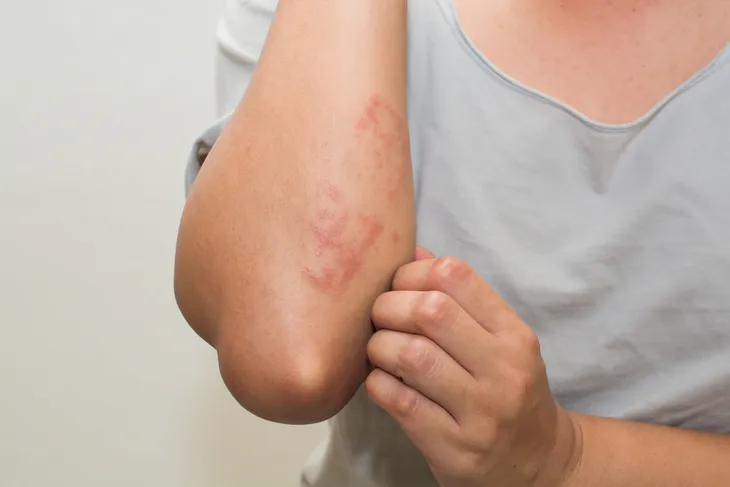You’ve heard people talk about shingles and how painful it can be. But what is it? It’s caused by the same virus as chickenpox. So, if you’ve gone through that already, you’re definitely at risk for developing shingles.
The painful, blistering rash can be somewhat mild for some but excruciating for others, which is why it should be taken seriously. Let’s look at 13 facts about shingles, including how to prevent it…
1. What is Shingles?
Shingles is a “distinctive, painful rash” in adults that can strike those who have the chickenpox virus lying dormant in their system, says WebMD. While the virus can be silent for years, in others, it “wakes up and travels along nerve fibers to the skin,” adds WebMD.
The most common location for shingles to develop is around the side of the waist, but it can also be highly visible and almost impossible to hide, occurring on one side of the forehead or around one eye.
2. More Than a Feeling
The severity of symptoms can vary from patient to patient, but shingles is never a pleasant experience. The Mayo Clinic says shingles will usually only affect one side of the body and is contained to a small area (but will bring much pain).
Telltale signs include pain, burning, and numbness or tingling in the affected area. The area will be very sensitive to touch, and the rash will typically show up a few days after the pain begins. There will also be itchiness and fluid-filled blisters that break open and crust over, explains the clinic. Some patients will also experience fever, headache, fatigue and even sensitivity to light.
3. What’s the Culprit?
We’ve already mentioned the chickenpox virus being responsible for shingles. But to get more specific, shingles is caused by the varicella zoster virus (VZV) (the clinical name for the chickenpox), according to the Centers for Disease Control and Prevention (CDC).
You’ll also hear the virus referred to as herpes zoster by some sources, but to be clear, shingles is not the sexually transmitted infection termed “herpes.”
4. It’s Contagious (Sort Of)
Shingles itself as a condition is not contagious, but the chickenpox virus is very contagious. According to MedicineNet.com, this means that, if you’ve never had chickenpox or the chickenpox vaccine, you can end up getting chickenpox from someone who has shingles if you come into direct contact with the blister fluid. You can’t directly pass shingles from one person to another.
The source says pregnant women in particular should avoid anyone who has visible signs of shingles. The good news is that it is not transmitted through coughing or sneezing, and is not contagious before the blisters appear. When the blisters have dried over, the contagious period is generally considered to be over.
5. When to Get Medical Intervention
EMedicineHealth.com says you should seek the assistance of a medical professional as soon as possible after the painful rash develops on one side of your body. It adds that antiviral medications are only effective up to 72-hours after the rash appears.
If the rash is on your face, you should consult a doctor immediately as the virus could spread to your eye and cause eye damage and even vision loss. A follow-up with an ophthalmologist (an eye specialist) is also recommended.
6. Pinpointing the Problem
There are a few ways a doctor can diagnose shingles and separate it from another problem causing a rash, notes Livestrong.com. It says one of the most common diagnostic methods is by simply assessing the symptoms.
However, a doctor may also obtain a blood test to detect increased white blood cells, as well as to identify antibodies associated with the herpes zoster virus. In some cases of uncertainty, a tissue sample may be taken to look at the cells under a microscope.
7. Worst Case Scenarios
We’ve already mentioned the possibility of eye damage from a shingles rash on the face, but there are other possible complications, notes the NSH in the UK. One is postherpetic neuralgia, which the source describes as “severe nerve pain (neuralgia) and intense itching that persists after the rash and any other symptoms of shingles have gone.”
There’s also Ramsay Hunt syndrome, which can cause hearing loss and dizziness (and even facial paralysis) to those having facial nerves affected by the chickenpox virus. Other complications include rash infections and scarring or loss of skin pigment in the affected area, as well as inflammation of the lungs, liver, brain, or spinal cord. These complications are more likely if you already have a weakened immune system, adds the NHS.
8. Who is at Risk?
Healthline reminds us that anyone who has had chickenpox can later develop shingles. However, while you can get shingles at any age, it’s most commonly associated with people in their 60s and 70s.
If there are factors that have weakened your immune system, you’re more likely to develop shingles from the reactivated virus, adds the source. “It’s not unusual to get shingles when you’re already sick or stressed,” it notes.
9. Vaccines and Other Prevention Methods
Fortunately, there’s a vaccine available that will reduce the chance of developing shingles if you’ve already had chickenpox. It’s called the Zostavax vaccine, and it’s targeted at people aged 60-years and older.
Meanwhile, MedicinePlus.gov says if you have shingles, you cn help prevent the spread of it by covering the rash and avoiding scratching it. You should also wash your hands frequently to be sure.
10. Will Shingles Disappear on Its Own?
The National Institute on Aging (NIA) says that most cases of shingles will last 3- to 5-weeks and will follow a pattern starting with the pain, then the rash, and then the blistering and subsequent crusting over.
It takes about 10-days for the blisters to dry up and crust over from the time the blisters develop. However, as we’ve already mentioned, there can be long-term complications that can sometimes be managed with treatment, which we’ll get to next.
11. There are Medical Treatments
The Mayo Clinic says there’s no cure for shingles, but “prompt treatment” with prescription antiviral medications can reduce symptoms and speed up recovery times.
Common antiviral medications to target shingles include acyclovir (Zovirax) or valacyclovir (Valtrex). However, your doctor may also opt to prescribe other drugs due to the sometimes excruciating pain involved. These drugs may include narcotics, anticonvulsants such as gabapentin (Neurontin), or even topical patches such as capsaicin (Qutenza). Injections of corticosteroids are sometimes also used.
12. Tackling Shingles at Home
Aside from the medical solutions, there are ways to help soothe the symptoms of shingles through home remedies. EMedicineHealth says you can apply cool tap water compresses to the weeping blisters for 20-minutes several times a day. “This also aids in removing the scabs and decreases the potential for bacterial infection,” the source explains. You can also soak in a cool bath, as hot water can aggravate shingles.
You can also use mild soap and water to keep the affected area clean, and apply petroleum jelly to aid in the healing process. In addition, wear loose clothing to avoid rubbing against the rash. You can also get non-prescription antihistamines (e.g., diphenhydramine [Benadryl] and topical creams (e.g., hydrocortisone) to help quiet the itchiness. Check out these natural treatments for shingles!
13. Try the “Shingles Diet”
Healthline also has a list of home remedies, but specifically mentions dietary changes to help combat shingles. The “shingles diet” is rich in vitamins A, B-12, C, E, and lysine, explains the source.
Foods that are natural sources of these vitamins include oranges, leafy greens, red meat, eggs, chicken, fish, dairy, whole grains, beans, and tomatoes. Avoid foods that are high in sugar, arginine (chocolate and nuts), and saturated fat while you have shingles.
















